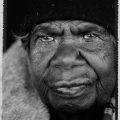Description
This beautiful table runner with Mitjili Napurrula’s design is part of our collaboration with Better World Arts.
Artwork Story:
‘Watiya Tjuta’
Napurrula’s father, Tupa Tjakamarra gave her the right to paint works related to Ilyingaungau in the Gibson Desert. This site, south of Walungurru (Kintore), some 520 kilometres west of Mparntwe (Alice Springs), is where the artist’s Mutikatjirri ancestors assembled their kulata (spears) for a conflict with the Tjukula men. Allusive works that refer to the straightening of kulata by Tjupurrula are among the landmark paintings of the Ikuntji Artists movement’s 30-year history.
The paintings of Napurrula and her husband, Long Tom Tjapanangka, have come to be understood as archetypical of Ikuntji art since they began to work with the arts centre in 1993. Napurrula remembers, ‘ … After I got married, my mother taught me my father’s Tjukurrpa in the sand, that’s what I’m painting on the canvas’. The white pigment eddies around abstract forms that refer to the spearwood trees. The tightly structured patterning of the key motifs and bold use of colour demonstrates the artist’s confidence in her individual artistic vision within a family of superlative artists – and the cultural heritage that continues to inform the myriad expressions of Western Desert artists.
Mitjili paints the Watiya Tjuta tree. Mitjili’s style is unique and recognisable. The Watiya Tjuta in Mitjili’s paintings is her father’s Tjukurrpa (dreaming) in Ilyingaungau country (Gibson Desert). This was passed down to her by her mother, Tjunkayi Napaltjareri when story telling, using the same to draw the story as it is told in the traditional way. She remembers “…After I got married, my mother taught me my father’s Tjukurrpa in the sand, that’s what I’m painting on the canvas”, a women’s interpretation.
Please Note: As these products are handmade, there may be minor variations in dye and design.
These table runners, chainstitched by Kashmiri artisans in India as part of a fair trade project with Better World Arts, show Keturah’s understanding of the landscape and its bold qualities.
Better World Arts
Has been operating for over two decades.
They work with traditional artisans from remote regions in Kashmir, Peru, West Bengal, Uttar Pradesh and Nepal (Tibetan refugees). They work with Australian Aboriginal artists from remote communities across Australia, from Arnhem Land to Central and the Western Desert regions, from rural locations and from cities.
Better World Arts are endorsed members of the Fair Traders Association of Australia and New Zealand.
Watiya Tjuta – Wool Table Runner (Multicolour)
Size
120 × 30 cm
Medium
wool
Catalog no
bwa-tablerunner-wool-mn-watiyatjuta-multicolour
Category
$100
Description
This beautiful table runner with Mitjili Napurrula’s design is part of our collaboration with Better World Arts.
Artwork Story:
‘Watiya Tjuta’
Napurrula’s father, Tupa Tjakamarra gave her the right to paint works related to Ilyingaungau in the Gibson Desert. This site, south of Walungurru (Kintore), some 520 kilometres west of Mparntwe (Alice Springs), is where the artist’s Mutikatjirri ancestors assembled their kulata (spears) for a conflict with the Tjukula men. Allusive works that refer to the straightening of kulata by Tjupurrula are among the landmark paintings of the Ikuntji Artists movement’s 30-year history.
The paintings of Napurrula and her husband, Long Tom Tjapanangka, have come to be understood as archetypical of Ikuntji art since they began to work with the arts centre in 1993. Napurrula remembers, ‘ … After I got married, my mother taught me my father’s Tjukurrpa in the sand, that’s what I’m painting on the canvas’. The white pigment eddies around abstract forms that refer to the spearwood trees. The tightly structured patterning of the key motifs and bold use of colour demonstrates the artist’s confidence in her individual artistic vision within a family of superlative artists – and the cultural heritage that continues to inform the myriad expressions of Western Desert artists.
Mitjili paints the Watiya Tjuta tree. Mitjili’s style is unique and recognisable. The Watiya Tjuta in Mitjili’s paintings is her father’s Tjukurrpa (dreaming) in Ilyingaungau country (Gibson Desert). This was passed down to her by her mother, Tjunkayi Napaltjareri when story telling, using the same to draw the story as it is told in the traditional way. She remembers “…After I got married, my mother taught me my father’s Tjukurrpa in the sand, that’s what I’m painting on the canvas”, a women’s interpretation.
Please Note: As these products are handmade, there may be minor variations in dye and design.
These table runners, chainstitched by Kashmiri artisans in India as part of a fair trade project with Better World Arts, show Keturah’s understanding of the landscape and its bold qualities.
Better World Arts
Has been operating for over two decades.
They work with traditional artisans from remote regions in Kashmir, Peru, West Bengal, Uttar Pradesh and Nepal (Tibetan refugees). They work with Australian Aboriginal artists from remote communities across Australia, from Arnhem Land to Central and the Western Desert regions, from rural locations and from cities.
Better World Arts are endorsed members of the Fair Traders Association of Australia and New Zealand.

